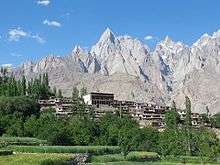Ghanche District
| Ghanche District ضلع گانچھے | |
|---|---|
| District | |
 Map of Gilgit–Baltistan with Ghanche District highlighted in maroon. | |
| Country | Pakistan |
| Province | Gilgit-Baltistan |
| Division | Baltistan |
| Capital | Khaplu |
| Area | |
| • Total | 4,052 km2 (1,564 sq mi) |
| Population (1998) | |
| • Total | 88,366 |
| Time zone | PST (UTC+5) |
| Website |
www |
Ghanche District(Urdu: ضلع گانچھے) (Balti: Gangchay) is the easternmost district of Gilgit–Baltistan, Pakistan.[1][2][3] To its northeast is Xinjiang (China), to the north and northwest is Skardu District, to its west is Astore District and to its south is Ladakh of Indian administered Jammu and Kashmir. The Actual Ground Position Line (AGPL) at the easternmost part of Ghanche District is located across the Saltoro Ridge. Territory east of the AGPL is currently controlled by India including the entire Siachen Glacier. It has been proposed by moderates in Pakistan and India to make the Siachen Glacier region a Peace Park. Pakistan controls west of Saltoro Ridge.
The capital of Ghanche District is Khaplu.[4] This region is the coldest place within Pakistan also called the "Third Pole" with temperatures reaching below -20 °C in the winter. Khaplu Valley and Hushe Valley form the gateway for the great Baltoro Muztagh, the subrange of Karakoram [5] that includes the mighty peaks of K2 (8,611 m), Broad Peak (8,047 m), Gasherbrums (8,000+ m) and Masherbrum (7,821 m) (all of which are included in the Skardu District).[6]
Etymology
The word Gangchay is Balti and means "glacier". It is locally used by natives of the Khaplu Valley for Shyok river which flows the length of Khaplu town. When the Pakistani government gave it the grade of district, people of the valley selected the name of "Ghanche" willingly.[7]
Administration
Khaplu consists of 56 blocks, each block containing many villages and these blocks have been divided into three subdivisions: Khaplu, Daghoni and Masherbrum. Four villages of Chorbat Valley were lost by Indian invasion in 1971. They were Chalunka, Tyakshi, Thang and Turtuk.[8] Some of them are given in the chart below.
| Name of Village/Town[9] | Muhallahs in the Village/Town |
|---|---|
| Khaplu Bala | Mouldomar, Sargaib, Stodkhoor (Braqchansar, Khanser, Banpi, Hundili Gharalti, Laxar), Khanqah, Naqzigroung, Gamba Bathong, Goma Bathong, Goma staqji (Muhsinabad), Langkhong (Islamabad),Hatchhe khar, Hatchhe,Tasawof Abad Hatchhe, Dinis(faizbaksh sector), Bngriya,Doqsa, Garbochung |
| Khaplu Pain | Kraming, Malaliwa, Ansoq, Kongbozang, Gongmayar, Baqerpi gund. Mekxerpi, Goqpi Mirpiser, Thaskong, Ghares, Morgoto, Helam groung, Braqchan, Chaqchan, mongrong, Beadenday, Hipi, Askari gond, Chilabatigond, Kowakhong, Stronpi, Konowa, Khsergroung, Garboung |
| Haldi |
Kharkoo Malayar, Mandik, Arabpa, Thana, Tranzong, Garbong, Yoskil, Tapari, Lahar, |
| Chorbat | Siksa (Kalan, Sokhmos), Chowar, Siari, Pion, Hassanabad, Ameerabad, Dawoo, Marcha, Partook, Thoqmus, Franu |
| Saling | Banpi |
| Thagas | Olday Groung, Garbi Groung, Kharat, Arif Abad, Chansoq, Newti Chan, Farol, Baqmacho, Kharkhor, Bandy Groung, Arappi Groung, Ool, Tholdi, Dung. |
| Yugo | Baqir Colony |
| Ghawari | Ghulu Khor, Manjar, Sain (Hill Town), Chogo Grong, Shahoba, Zangi Ba, Manowa, Sobi Gon, Rahinpi Khor, Mala Abdul pi khor, Mayokhor, Duskhor, Soq, Gintha |
| Kuro | Farool, Khankah grong, Sato, Gharaqpi gond, Katchurdas, |
| Gulshan-e-Kabir | Tranzong, Gonpon, Kharkhor (Kharkhor & Bongri), Farol (Gapkhor & Yarol) |
| Ghursay | |
| Talis | Nima bazar, hussani chock, |
| Saltoro | |
| Surmo | Choghogrong, Tarkari, Tishari, Gond, Khar |
| Kundos | Karmanding, Choghogrong, Lachat, Thang, Hano, Khorkondo |
| Machulu | Ashurpi, Malikpi, Manthalpi, Khadi, Badawa, Hilbi, Mallon, Teshari, Marin, Bongri, Baqdurpi |
| Balghar | Lahar, marmung |
| Hushe | |
| BARA Valley Baltistan | Gumba BARA (Hilfiyuoq, Kharfiyouq, Bara Gond, BrouqPa, Thupori), Gungma BARA (Spinpi, Sampa, MantholPa, Khanka,Pandiva, ChounPa, Mirikpa, Shourova, MominPa, QadeerPa, Tatous) |
| Thalay | Haltagari Baltoro, daltir, yarkhor,taso,harangus,parangus,chondu,khasomik,bordas,gaworic,lodas. |
Religion
All the people living in Ghanche are Muslims and mostly people belong to Nurbakhshi (90%) branch of Islam whereas there are Shia Ithna-ashri and others (10%) Muslims as well. The scholar is religious leader called ‘Bowa’ in local language and has very important place in society.
Education
According to the Alif Ailaan Pakistan District Education Rankings 2015, Ghanche is ranked 54 out of 148 districts in terms of education. For facilities and infrastructure, the district is ranked 98 out of 148.[10]
See also
- Geography of Gilgit-Baltistan
- Districts of Gilgit–Baltistan
- 2012 Siachen Glacier avalanche
- Noorbakhshia
- Dras
References
- ↑ "The serenity of Ghanche: Of mountains, rivers and valleys".
- ↑ "Mapping education in Pakistan 2015".
- ↑ "Rifts within Nurbakhshiyas: Dozens arrested after clashes in Ghanche Valley".
- ↑ "Khaplu — off the beaten path".
- ↑ Balghari, Sajjad H:"Sayyid Muhammad Nurbakhsh Qahistani", Monthly Nawa-i-Sufia, Islamabad, Issoue No.12, 1995
- ↑ "History of Ganche and places to see".
- ↑ Arz-e-Shimal by Alhaj Muhammad Ibrahim Zair
- ↑ "geography of baltistan".
- ↑ District Body Ghanche
- ↑ "Individual district profile link, 2015". Alif Ailaan. Retrieved 2015-05-07.
